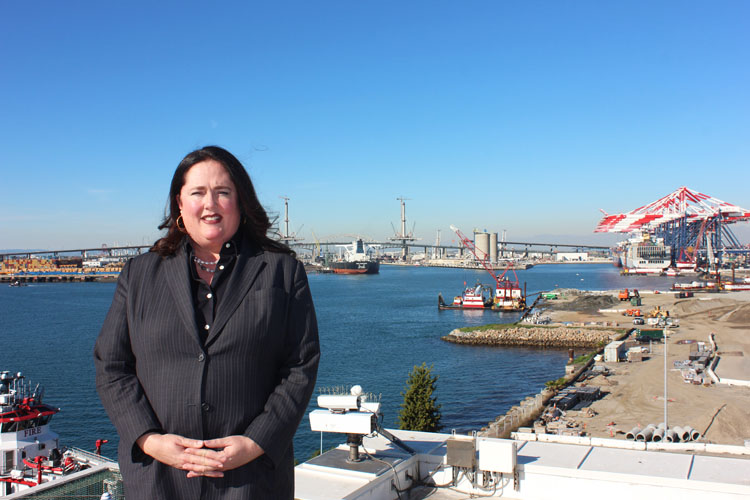The Port of Long Beach (POLB) is receiving more than $147 million in public and private funds to develop six projects for zero-emissions equipment and advanced energy systems for its operations. These projects are intended to demonstrate the feasibility of meeting the goals outlined in the 2017 Clean Air Action Plan (CAAP), which called for a transition to zero-emissions cargo-handling equipment by 2030 and zero-emissions trucks by 2035. CAAP pertains to both POLB and the Port of Los Angeles.
“There is no other port complex in the world that is doing the level of testing and demonstration that we are in terms of zero-emission equipment,” Renee Moilanen, manager of air quality practices at POLB, told the Business Journal.
In total, the port has received more than $78 million in grants from the California Energy Commission (CEC) and the California Air Resources Board (CARB), as well as almost $69 million in matching funds from other sources, for the development of the following projects:
- The Zero-Emissions Terminal Equipment Transition project, one of the nation’s largest demonstrations for zero-emissions cargo handling equipment, received $9.7 million from CEC. To be undertaken at Piers G, J and F, the project involves the deployment of nine electric gantry cranes, 12 yard tractors, four hybrid and electric drayage trucks, as well as workforce training programs.
- The Sustainable Terminals Accelerating Regional Transformation (START) project has received $50 million from CARB. It funds 34 pieces of zero-emission cargo handling equipment designated for Pier C.
- The Port Advanced Vehicle Electrification (PAVE) project has received $8 million from CEC to deploy electric infrastructure at Pier T.
- A proposal to develop an electricity micogrid at the Joint Command and Control Center (JCCC) on Pier F received $5 million from CEC.
- The Commercialization of POLB Off-Road Technology (C-PORT) demonstration project received $5.3 million from CARB. It includes a head-to-head comparison of a hydrogen yard truck with a battery-electric yard truck.
- The Port Community Electric Vehicle Blueprint project received $200,000 from CEC. The blueprint would provide a path towards an electric transition that other ports could replicate.
“The grant funds from the public agencies have been very significant in advancing these demonstrations, but there’s also a lot of private dollars that are going into these demonstrations as well,” Moilanen said.

Tracy Egoscue, president of the board of harbor commissioners and an environmental lawyer by trade, said that the move to zero-emission equipment is the next stage of the port’s green efforts. The transition is a challenge, Egoscue said, in part because the technology to realize that goal hasn’t been fully developed. Particularly, impacts related to future costs must be analyzed. But that does not make it impossible, she emphasized. “Starting at the very beginning with the Green Port Policy, there were a lot of people saying, ‘We’re not ready for this yet and we’re never going to get there.’ You can see how far we’ve come,” she said.
The Long Beach Board of Harbor Commissioners adopted its Green Port Policy in January 2005. This guide for environmentally-friendly port operations included goals for reducing port-related emissions of ocean-going vessels, heavy-duty trucks, harbor craft, cargo-handling equipment and trains. According to its website, the port has since cut emissions of nitrogen oxides by 48%, diesel particulates by 84% and sulfur oxides by 97%.
In developing new technologies to meet its clean air goals, Egoscue said the financial support from both state agencies and private firms is highly encouraging. “One of the benefits to the recent grants and commitments we’ve received . . . is the idea that we will facilitate and incentivize the development of the equipment,” she said. “I think we will engineer our way there.”
Some of the new electric equipment will begin rolling out in the next few months, Moilanen said. The bulk of the deployment is set to occur in 2020. “We’ve already started building out the charging infrastructure that has to be in place before the equipment comes in,” she said.
Through the PAVE program, the port would design, install and deploy electrical charging infrastructure to support battery-electric yard tractors and forklifts at the Total Terminals International facility at Pier T.
Meanwhile, CARB has directed $50 million towards the START Project, which includes not only the Port of Long Beach but also the ports of Oakland and Stockton. Funds from this project would go towards the deployment of approximately 100 pieces of zero-emission terminal equipment to be distributed across all three ports. “We recognize that Long Beach cannot drive this effort towards zero emissions alone,” Moilanen said. “We are partnering with these other ports so we can share our lessons learned.”
One-third of the equipment being developed for the START project is going to Long Beach, including two container ships, an electric tugboat, five electric trucks and two heavy-duty truck charging outlets. Additional funding is being provided by both public and private organizations through cash and in-kind contributions. These contributors include the ports of Long Beach, Oakland and Stockton; the South Coast Air Quality Management District; Southern California Edison; Tetra Tech; Harley Marine Services; Matson; Shippers Transport; and SSA Marine.
The microgrid project at the JCCC, currently in its pilot phase, would enable the facility to generate local power, store it and protect against failure of the larger centralized grid. “If the port can create and understand [energy] storage, then we’ll also be able to add that to our [reduced] footprint,” Egoscue said.
“The cooperation of the entire goods movement industry is going to be necessary to make these goals come to fruition,” Moilanen said. “We have been very fortunate that our Long Beach business partners are stepping up and engaging with us in these demonstrations and helping us to take those steps towards a zero-emissions future.”
